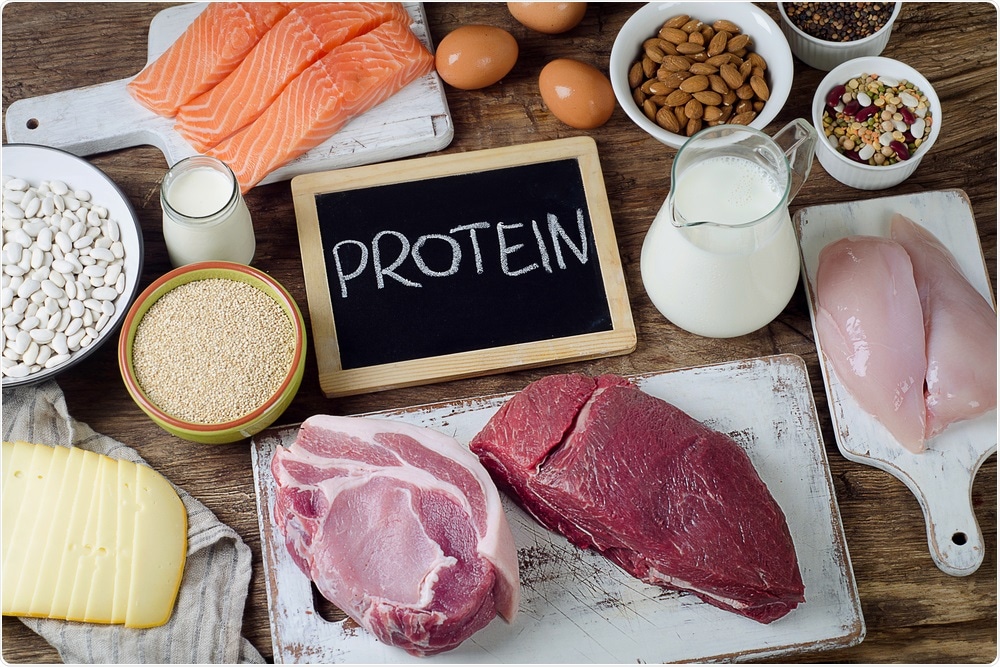The synthesis of the functional and structural components of living cells requires essential amino acids from dietary protein. Therefore, the quality and quantity of protein foods are essential for good health.

Protein in Diet. Image Credit: Tatjana Baibakova/Shutterstock.com
To help consumers meet their protein requirements with a wide range of protein sources, the 2020-2025 Dietary Guidelines for Americans (DGAs) has published an “ounce equivalents” recommendation.
For instance, the DGAs present a wide range of “ounce equivalents” in the protein food groups, citing that 1 oz. of meat is equivalent to 2 oz. of tofu, ½ oz. of mixed nuts, ¼ cup of red kidney beans, 1 cooked egg, and 1 tablespoon of peanut butter.
But the DGAs do not presently address the problem of differences in protein quality related to different food sources. Generally, animal proteins have a better essential amino acid profile and higher protein digestibility with respect to dietary requirements. Such measures of protein quality suggest that animal proteins can more readily supply the daily requirement of essential amino acids when compared to plant protein.
Recently published in The Journal of Nutrition, a new article analyzed the physiological response to numerous ounce equivalents of protein food sources and observed that the consumption of ounce equivalents of animal-based protein food sources led to a greater gain in whole-body net protein balance above baseline when compared to the ounce equivalents of plant-based protein food sources.
Robert Wolfe from the University of Arkansas for Medical Sciences and collaborators arbitrarily assigned 56 young healthy adult participants to one of seven food intervention groups—that is, 2 oz. of cooked pork loin, 2 oz. of cooked beef sirloin, 4 oz. of tofu, 1 oz. of mixed nuts, ½ cup of red kidney beans, 2 cooked eggs, and 2 tablespoons of peanut butter.
Before the commencement of the study, participants followed three-day dietary weight maintenance. The net whole-body protein balance of these participants was also assessed using a stable isotope tracer infusion procedure. The baseline changes following the consumption of different protein food sources were evaluated against the baseline value for that specific individual.
On the whole, the researchers found that animal-based protein food sources triggered greater anabolic responses when compared to plant-based protein food sources. Moreover, whole-body protein balance was higher in the eggs, pork, and beef groups than in the groups consuming plant-based protein food sources.
Increased protein synthesis was also seen in the beef group than in the groups consuming plant-based protein foods, like peanut butter, mixed nuts, or kidney beans. Compared to mixed nuts, the pork and egg groups inhibited the breakdown of proteins much more. The extent of the whole-body net balance response was associated with the content of essential amino acids in the protein food source.
The researchers surmised that “ounce equivalents” of protein food sources as stated in the DGAs are not metabolically equivalent in terms of either the caloric value or anabolic response. DGAs should consider this aspect when developing new approaches to establish healthy eating patterns.
Our research illustrates that animal-based protein foods, such as beef, eggs, and pork, and plant-based protein foods, such as kidney beans, peanut butter, tofu, and mixed nuts, cannot be considered to be equivalent, or a substitute for each other, when developing healthy dietary patterns, given their unique physiological effects.”
Robert Wolfe, PhD, Lead Researcher and Director, Center for Translational Research in Aging and Longevity
Wolfe, who is also a Professor of Geriatrics from the University of Arkansas for Medical Sciences, added, “While it's well-established that animal proteins can more readily provide essential amino acids than plant protein foods, our study also indicates that eating animal protein foods such as beef, pork and eggs may lead to increased protein synthesis, which has been shown to have benefits such as improved satiety and lean muscle mass maintenance.”
A similar editorial piece by Glenda Courtney-Martin from the University of Toronto underscores the significance and timely contribution of this research work. This study could guide upcoming decisions regarding how protein foods can be better classified by the DGAs.
Source:
Journal reference:
Park, S., et al. (2021) Metabolic Evaluation of the Dietary Guidelines’ Ounce Equivalents of Protein Food Sources in Young Adults: A Randomized Controlled Trial. The Journal of Nutrition. doi.org/10.1093/jn/nxaa401.